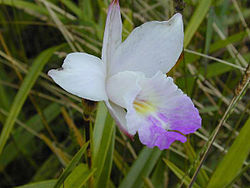- Arundina
-
Bamboo orchid 
Scientific classification Kingdom: Plantae Division: Magnoliophyta Class: Liliopsida Order: Asparagales Family: Orchidaceae Subfamily: Epidendroideae Tribe: Arethuseae Subtribe: Bletiinae Alliance: Arundina Genus: Arundina
Rich.Species: A. graminifolia Binomial name Arundina graminifolia
(D.Don) Hochr.The bamboo orchid (Arundina graminifolia; syn. Arundina bambusifolia Lindl., Arundina speciosa Blume, Bletia graminifolia D.Don) is a species of orchid and the sole of the genus Arundina. This tropical Asiatic genus extends from India, Nepal, Thailand, Malaysia, Singapore, South China to Indonesia and across the Pacific Islands. It has been introduced in Puerto Rico, Costa Rica, Panama and Hawaii.
The bamboo orchid is a terrestrial multiperennial orchid with reedy stems, forming into large clumps growing to a height between 70 cm and 2 m.
The plaited linear leaves are oblong lanceolate, with a length of 9 to 19 cm and a width of 0.8 to 1.5 cm. The apex is acuminate. There are amplexicaul (clasping the stem) sheathing stipules.
This orchid blooms in summer and autumn, showing rather open clusters of showy terminal flowers, ten at the most. They bloom in succession on the terminal racemes, which are 7 to 16 cm long. These flowers, 5 – 8 cm in diameter, are a rosy lilac and white disk with a purple lip. The bracts are wide triangular and surround the main stalk of the flower cluster. The occasional fertilized seed pods contain minute powdery seeds, and small plants often develop near the cane ends after flowering, and likely aid in propagation if allowed to reach the soil.With only 200 of the plant to be recorded growing naturally in Singapore, the species is close to extinction there, largely caused by the destruction of its natural habitat, namely the rainforests and mangrove forests. The remaining plants, commonly called Tapah weeds, can be found in the secondary forests or at the forest fringes. It is however very common in road cuts and other disturbed areas in full sun in Sarawak, East Malaysia, where it often is the most common flowering plant to be seen along the roadsides.
Categories:- Orchid genera
- Orchid species
- Flora of Indonesia
- Flora of Malaysia
- Flora of Singapore
- Flora of Thailand
Wikimedia Foundation. 2010.

